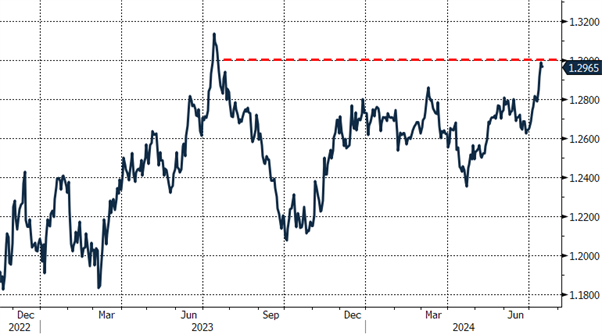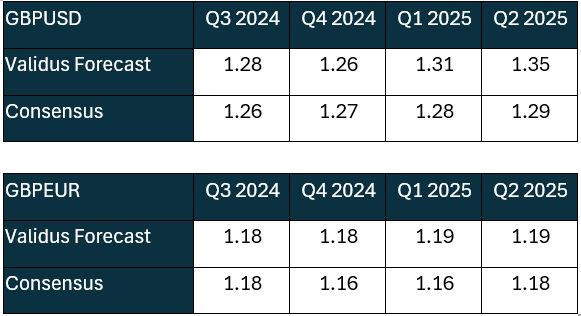
A Nation at the Crossroads: France’s Election Results and The Impact on Europe
10 July 2024
Bipartisan markets also hold risks
25 July 2024INSIGHT • 16 JULY 2024
Is this the Rachel Reeves Rally?

Marc Cogliatti, Head of Capital Markets EMEA
Last week, sterling advanced to its highest level against the dollar in a year and touched its highest-level versus the euro in almost two years. The new highs for the pound come exactly a week after the results of the general election were announced, leading many participants to question whether the new leadership has been the catalyst for the latest rally.
Chart 1: GBPUSD 2023 – to date

Political stability is typically a good thing for a currency. A Labour majority was almost a certainty, with the only question being how big the majority would be. Looking ahead, there is still some uncertainty about Labour’s policies, which will likely remain the case until after the summer break. Consequently, we believe this rally is less about politics and more about economics and the outlook for interest rate differentials.
Last week’s UK GDP figures showed the economy expanding 0.4% month on month in May, compared to expectations of a 0.2% gain. The stronger than expected growth was fuelled by recoveries in retail sales and construction, both of which suffered in April due to the extremely wet weather. Meanwhile, services grew by 1.1% in the three months to May, the fastest pace since December 2021. The news will be welcomed by the new Government as it means more in the coffers to fund spending plans, but less so by the Bank of England as it continues the battle to control inflation.
The market suggests it's currently a 50:50 call on whether the MPC will decide to cut rates in August or wait until September. Tomorrow’s CPI print for June may well be the deciding factor. Economists’ expectations are for a reading of 1.9% y/y (just below the BoE’s 2% target), but a stronger reading may result in the committee waiting for another month before pulling the trigger.
MPC Split
The MPC is clearly split in its thinking, but in the words of Huw Pill, the Bank’s chief economist, “we’re in a world of when rather than if.” Jonathan Haskell and Catherine Mann both favour the side of caution against inflation and cite the tight labour market as a reason for keeping policy unchanged in August. Meanwhile, Swati Dhingra is keen to cut rates to stop the squeeze on living standards now that inflation has eased. One factor that may delay a rate cut is that Clare Lombardelli, the new deputy governor, is deemed more of a hawk than Ben Broadbent, the member she’s replacing next month.
We continue to stand by our view that the committee should wait amid the risks of a resurgence in inflation. Whilst heading CPI is back to target, core CPI (excluding the volatile food and energy components) still sits at 3.5% while services inflation, which is most closely linked to the domestic economy, is still running at 5.7%.
Meanwhile, the OIS curve is now fully pricing in a 25bps cut from the Fed in September (it was only ~60% priced in a month ago) and a total of -60bps are priced in for year-end versus -40bps last month. In Europe, the ECB look set to cut by another 25bps in September and a further 25bps in December.
Best of a Bad Bunch
As a result, sterling looks to be the best of a bad bunch from a relative yield perspective, and we see this as the main justification for the pound’s recent gains. When considering the impact of hedging, interest rate differentials mean the pickup for a USD fund hedging GBP assets is now only 5bps (when using a 1-year hedge) vs +18bps a month ago.
As regular readers will know, we have had a bullish bias for sterling, primarily against the dollar, since the beginning of 2024 and after a relatively quiet start to the year, this finally seems to be gathering some momentum. Both GBPUSD and GBPEUR are now approaching key psychological levels at $1.30 and €1.20, respectively, which may halt progress in the short term, but ultimately, the recent advance only adds confidence to our view.
As a reminder, our latest forecasts are shown below:
Chart 2: Validus Forecast

Be the first to know
Subscribe to our newsletter to receive exclusive Validus Insights and industry updates.



